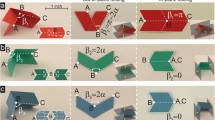Abstract
Kirigami is a Japanese art of paper cutting. It is used to obtain three-dimensional shapes via cutting and folding the paper. Origami, however, is based on a series of precise geometric folding without any other changes to the paper. With the characteristics of dimensional change and form transformation as well as the advantages of being able to expand and zoom, both Kirigami and Origami have great potential in cross-domain applications. These include biomedical materials, deformable robots, adaptable building cortex, and aerospace science. These applications show different requirements for folding by Kirigami or Origami. This study considered that the knowledge of design must include the operational process used to solve design problems.
Access this chapter
Tax calculation will be finalised at checkout
Purchases are for personal use only
Similar content being viewed by others
References
Alexander, C., Sara, I., Murray, S.: A Pattern Language. Oxford University Press, New York (1977)
Callens, S.J.P., Zadpoor, A.A.: From flat sheets to curved geometries: origami and kirigami approaches. Mater. Today 21(3), 241–264 (2018)
Demaine, E.D., Demaine, M.L.: Fold-and-Cut Magic, Tribute to a Mathemagician, pp. 23–30. A K Peters (2004)
Demaine, E.D., O’Rourke, O.P.C.S.J.: Geometric Folding Algorithms: Linkages, Origami. Cambridge University Press, Polyhedra (2014)
Dureisseix, D.: An overview of mechanisms and patterns with origami (2012)
Temko, F.: Kirigami: the creative art of paper cutting (1962)
Francis, K.C., Rupert, L.T., Lang, R.J., Morgan, D.C., Magleby, S.P., Howell, L.L.: From crease pattern to product: considerations to engineering origami-adapted designs Paper Presented at the 38th Mechanisms and Robotics Conference, Buffalo, New York, USA (2014)
Gardiner, M., Aigner, R., Ogawa, H., Hanlon, R.: Fold mapping: parametric design of origami surfaces with periodic tessellations. Origami 7, 105–118 (2018)
Jackson, P.: Folding Techniques for Designers: From Sheet to Form. Laurence King Publishing, London (2011)
Lang, R.J.: Origami Design Secrets: Mathematical Methods for an Ancient Art. AK Peters, Natick (2003)
Miura, K.: Method of packaging and deployment of large membranes in space. Inst. Space Astronaut. Sci. Rep. 618, 1–9 (1985)
Rafsanjani, A., Bertoldi, K.: Buckling-induced Kirigami. Phys. Rev. Lett. 118(8) (2017). https://doi.org/10.1103/physrevlett.118.084301
Saito, K., Pellegrino, S., Nojima, T.: Manufacture of arbitrary cross-section composite honeycomb cores based on origami techniques. J. Mech. Des. 136, 051011 (2014)
Sloman, P.: Paper: Tear, Fold, Rip, Crease, Cut: Black Dog (2009)
Tachi, T.: Generalization of rigid-foldable quadrilateral-mesh origami. J. Int. Assoc. Shell Spat. Struct. (IASS) 50(3), 173–179 (2009)
Tachi, T.: Freeform variations of origami. J. Geom. Graph. 14(2), 203–215 (2010)
Tachi, T.: Freeform rigid-foldable structure using bidirectionally flat-foldable planar quadrilateral mesh. Adv. Archit. Geom. 2010, 87–102 (2010)
Tachi, T.: Designing freeform origami tessellations by generalizing Resch’s patterns. J. Mech. Design 135(11), 111006-111006-111010 (2013). https://doi.org/10.1115/14025389
Terzidis, K.: Expressive form: A Conceptual Approach to Computational Design. Spon Press, London, New York (2003)
Tibbits, S.: 4D printing: multi-material shape change. Archit. Design 84(1), 116–121 (2014)
Zirbel, S.A., Trease, B.P., Thomson, M.W., Lang, R.J., Magleby, S.P., Howell, L.H.: HanaFlex: a large solar array for space applications. Paper Presented at the Micro-and Nanotechnology Sensors, Systems and Applications VIl, Baltimore, Maryland, USA, 20–24 April 2015
Author information
Authors and Affiliations
Corresponding author
Editor information
Editors and Affiliations
Rights and permissions
Copyright information
© 2022 The Author(s), under exclusive license to Springer Nature Switzerland AG
About this paper
Cite this paper
Chen, CH., Lin, MC. (2022). CFFU Cycle Design Mode of Programmable Creases - An Example of Fibonacci Folding Sequence Pattern. In: Rauterberg, M. (eds) Culture and Computing. HCII 2022. Lecture Notes in Computer Science, vol 13324. Springer, Cham. https://doi.org/10.1007/978-3-031-05434-1_12
Download citation
DOI: https://doi.org/10.1007/978-3-031-05434-1_12
Published:
Publisher Name: Springer, Cham
Print ISBN: 978-3-031-05433-4
Online ISBN: 978-3-031-05434-1
eBook Packages: Computer ScienceComputer Science (R0)




